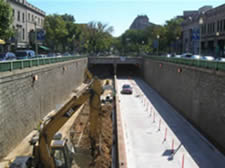Road Closure and Lane Closure
Project Spotlight
I-385 Rehabilitation (South Carolina) - The South Carolina DOT (SCDOT) closed 15 miles of I-385 in Laurens County in January 2010 for rehabilitation. This was the first time SCDOT implemented full road closure for a non-emergency project. Doing so allowed SCDOT to complete the project in less than eight months instead of three years if lanes were kept open and save more than $34 million. The rehabilitated stretch of I-385 officially reopened three weeks ahead of the eight-month schedule, and under budget.
Full road closures, partial road closures, and lane closures all facilitate the completion of roadway construction projects. When applied strategically, these approaches can serve as effective ways to manage safety and disruption to traffic in work zones. This page includes information on each of these construction strategies:
For resources, guidance, and tools on analyzing the impacts of road and lane closures, visit Work Zone and Traffic Analysis.
Full Road Closure
Full road closure is designed to eliminate the exposure of motorists to work zones and workers to traffic by temporarily closing a facility for rehabilitation or maintenance. During full road closure, traffic is detoured, allowing workers full access to roadway facilities. It is not suitable for all construction situations. In applicable situations, use of full road closure can result in positive public sentiment, increased productivity, reduced project duration, increased safety and/or a shortened risk period, and in some cases cost savings. A full closure approach may be used for an extended period of time, on weekends or nights, or directionally on a segment of roadway.

- Safely Implementing Rolling Roadblocks for Short-term Highway Construction, Maintenance, and Utility Work Zones (HTML, PDF 648KB) - This Fact Sheet summarizes best practices related to rolling roadblocks for short-term road work activities requiring a short-term full closure of the roadway.
-
TH-36 (Minnesota DOT)
In 2007, the Minnesota DOT (Mn/DOT) embarked on a five-month full closure to reconstruct a 2-mile segment of Highway 36, a high-volume, commuter-heavy roadway that passes through North St. Paul. The decision to use full closure was based on the projected savings in project time and cost, increased safety, and the results of a public survey. An analysis determined that full closure would lead to a 70% reduction in the duration of traffic impacts in comparison to a partial facility closure. A public survey and input from local businesses and residents affected by the project indicated that respondents were split 50/50 over whether to use full or partial closure. Assessing the full closure option further, Mn/DOT did a cost benefit analysis and determined that full closure would be better. Without a clear public preference, Mn/DOT decided to go with full closure. A survey after the project ended indicated that the surrounding community agreed with the use of full closure and was satisfied with the project. Because this was the largest full closure in Minnesota history, Mn/DOT funded a study by the University of Minnesota to evaluate all traffic alternatives, compare costs and benefits across alternatives, conduct market research to gauge public acceptance during and after the project, and identify lessons learned for future projects.
- H-36 Full Closure Construction: Evaluation of Traffic Operations Alternatives
- "Innovation Cuts Construction Time by a Year on Minnesota Project" - Article in May/June 2011 issue of FHWA Innovator.
- "A Mix of Innovations Succeeds in Minnesota" - Article in May/June 2009 issue of FHWA Public Roads.

Partial Road Closure
Partial road closure involves the closure of one side of the freeway during reconstruction projects. Traffic is shifted to the other side of the freeway, rather than detoured, which distinguishes this type of closure from full closure.
I-70 (Indiana DOT)
The Super 70 project was a $175 million reconstruction of a 6-mile stretch of I-70 in Indianapolis, completed between 2006 and 2008. To accelerate work, Indiana used partial closures—shutting down selected ramps and one side of the interstate at a time. A moveable barrier wall allowed lane adjustments during rush hours, providing 3 inbound lanes in the morning and 3 outbound lanes in the evening to maintain traffic flow.
- "Still Hyper Active" - Article in June 2007 issue of Roads & Bridges Magazine, Volume: 45 Number: 6.
Lane Closure
- Lane Closure Policies - Provides examples of lane closure policies or strategies that State DOTs use as guidance in determining daily permitted lane closure times.
To view PDF files, you need the Adobe Acrobat Reader.
To view WMV files, you need the Windows Media Player.
